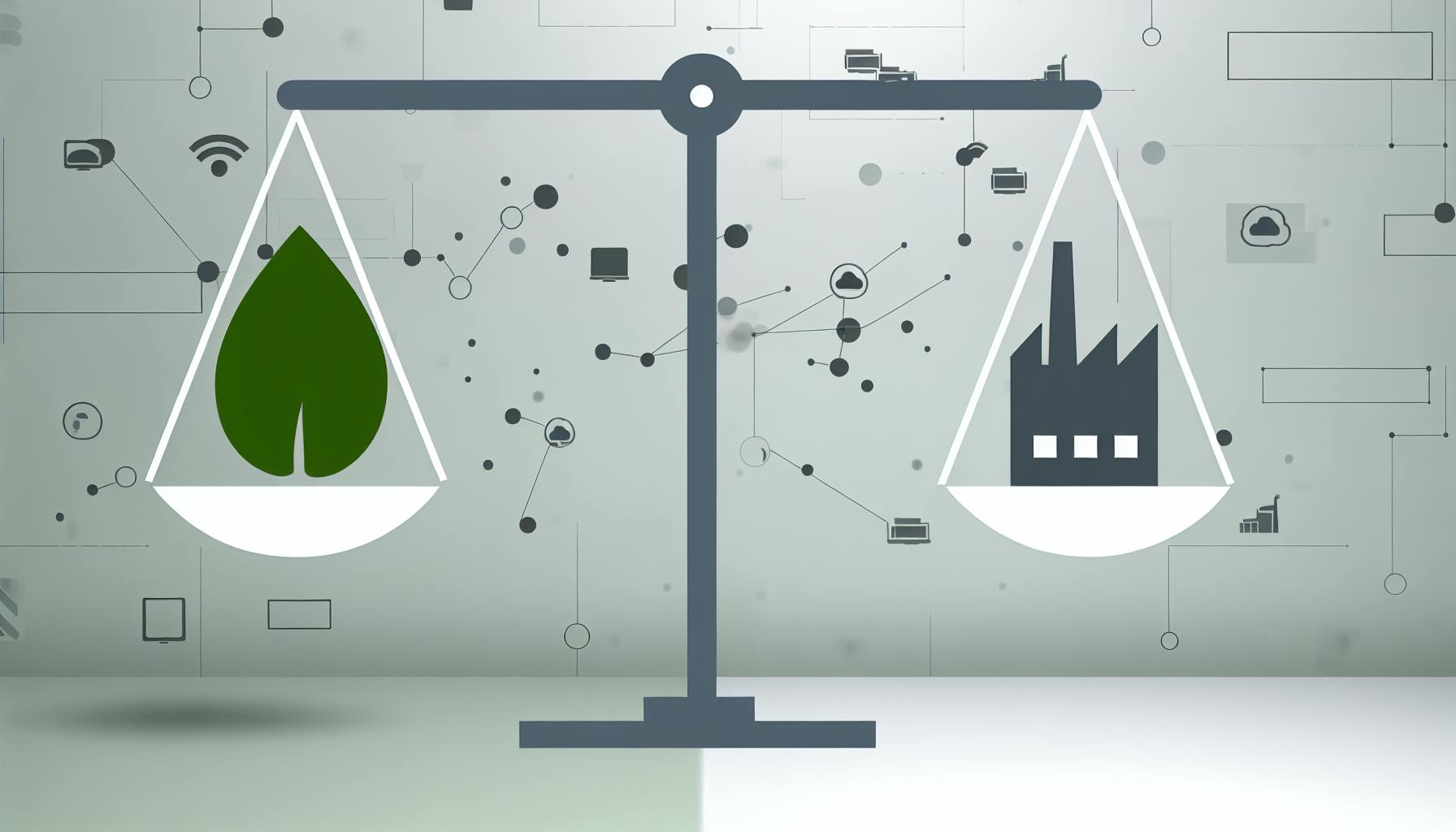Measuring greenhouse gas emissions can seem daunting for small and medium enterprises (SMEs).
Yet with the Greenhouse Gas Protocol, SMEs now have a clear framework enabling them to effectively measure and manage their climate impact.
In this post, you'll get an introductory overview of the key aspects of the Protocol and practical guidance on how to apply them within your small or medium business.
Greenhouse Gas Protocol Introduction for SMEs
This section will offer an overview of the Greenhouse Gas Protocol and its relevance for small to medium-sized enterprises (SMEs) striving for effective emissions management.
The ABCs of GHG Emissions for Businesses
Defining what GHG emissions are, their environmental impact, and the imperative for SMEs to understand and manage their emissions responsibly.
GHG emissions refer to the release of greenhouse gases such as carbon dioxide (CO2), methane (CH4), and nitrous oxide (N2O) into the atmosphere. These emissions trap heat, causing global temperatures to rise overtime and leading to climate change.
As key contributors to GHG emissions, businesses have a responsibility to measure and manage their environmental impact. For SMEs, taking early action puts them in a strong position to get ahead of tightening regulations, demonstrate leadership to stakeholders, reduce operating costs, and identify new market opportunities.
However, SMEs often lack the expertise or resources to implement rigorous GHG accounting. This is where internationally recognized frameworks like the Greenhouse Gas Protocol provide accessible guidance.
The Business Case for Emissions Management
Exploring the intersection of environmental stewardship and business value, detailing the risks and opportunities associated with GHG emissions management.
Beyond ethical motivations, sound business sense is driving enterprises towards emissions reduction strategies. Investors and customers increasingly favor companies with strong sustainability credentials. By contrast, inaction raises reputational risks and the likelihood of financial penalties down the track as regulations tighten.
For lean SMEs, emissions management delivers direct cost savings through energy efficiency initiatives. The incentives go further still - governments actively support decarbonization efforts with subsidies, tax breaks and partnerships.
First movers stand to benefit the most. By embedding emissions management into operations early, SMEs position themselves for new revenue in emerging green markets.
Overcoming Emissions Measurement Hurdles
Addressing common challenges SMEs face when measuring GHG emissions and providing insights into accessible solutions.
Lacking dedicated sustainability teams, SMEs struggle to accurately measure GHG inventories across the Greenhouse Gas Protocol scopes. Without a baseline, setting informed reduction targets is near impossible.
Automated carbon accounting platforms provide a simple, cost-effective solution. Applying best practice GHG methodologies, they deliver customized tracking aligned with business activities - no manual number crunching required.
With granular data on emission sources, SMEs can identify “hot spots” to prioritize for reduction initiatives. Ongoing tracking enables performance monitoring against targets over time. Transparent GHG accounting builds stakeholder trust and ensures regulatory compliance.
What is the protocol for greenhouse gases?
The GHG Protocol, or Greenhouse Gas Protocol, is the most widely used international framework for measuring greenhouse gas (GHG) emissions. It aims to help businesses and governments calculate, report, and reduce their carbon footprint with accuracy and credibility.
The GHG Protocol provides standards, guidance, tools, and training to quantify GHG inventories for various categories. This includes:
- Corporate emissions
- Product life cycles
- Cities
- Value chains
It outlines three scopes for categorizing direct and indirect emissions:
- Scope 1 covers direct emissions from owned or controlled sources.
- Scope 2 covers indirect emissions from purchased electricity, heating, or cooling.
- Scope 3 includes all other indirect emissions across the value chain.
Whether your SME is just starting the sustainability journey or further along, applying the GHG Protocol enables:
- Identifying the largest sources of emissions
- Setting credible reduction targets
- Tracking performance over time
- Reporting and communicating climate action
With growing pressure from stakeholders to demonstrate climate responsibility, gaining proficiency in the GHG Protocol is key for SMEs on the path to net zero.
What is the greenhouse gas product protocol?
The Greenhouse Gas (GHG) Protocol is an internationally recognized standard for measuring and managing greenhouse gas emissions from private and public sector operations, value chains, products, cities, and policies.
Developed through a multi-stakeholder partnership convened by the World Resources Institute (WRI) and the World Business Council for Sustainable Development (WBCSD), the GHG Protocol provides guidance and standard frameworks for companies and other organizations to prepare a comprehensive, corporate-level emissions inventory.
Key aspects of the GHG Protocol include:
- Defining different scopes of emissions:
- Scope 1 covers direct emissions from owned or controlled sources
- Scope 2 covers indirect emissions from the generation of purchased electricity, steam, heating and cooling
- Scope 3 includes all other indirect emissions that occur in the value chain
- Ensuring consistent measurements, reporting, and verification of greenhouse gas emissions
- Helping companies set emission reduction targets and track performance over time
- Enabling transparency and credibility of publicly reported emissions data
By providing a common standard and approach, the GHG Protocol allows companies like SMEs to accurately measure their carbon footprint, identify high-impact areas to reduce emissions, and benchmark sustainability performance. Integrating the protocol into business operations is an important first step for SMEs on the path towards net zero emissions.
What are the 5 principles of GHG Protocol?
Adhering to key principles ensures your emissions inventory provides a complete, consistent, and accurate account of your company's footprint. The GHG Protocol outlines 5 core principles:
Relevance
Focus your inventory on emissions sources that significantly contribute to your overall footprint. Prioritize measuring Scope 1 and 2 emissions, as well as relevant Scope 3 sources.
Completeness
Account for all greenhouse gas emission sources within your inventory's scope. Disclose and justify any exclusions.
Consistency
Use consistent methodologies and data sources year-over-year. Document any changes to allow for meaningful comparisons.
Transparency
Address all relevant issues openly and honestly. Disclose all relevant methods, data sources, and assumptions.
Accuracy
Ensure your inventory reflects the actual greenhouse gas emissions as accurately as possible. Apply due diligence to reduce uncertainties as much as practicable.
Adhering to these principles ensures your company's inventory serves as a useful baseline and decision-making tool for driving reductions.
sbb-itb-919600f
What is the GHG Protocol methodology?
The Greenhouse Gas (GHG) Protocol is the most widely used international standard for measuring greenhouse gas emissions from private and public sector operations. Developed by the World Resources Institute (WRI) and the World Business Council for Sustainable Development (WBCSD), it provides standards and guidance for companies and other organizations to prepare a greenhouse gas emissions inventory.
Some key aspects of the GHG Protocol methodology include:
-
Defining organizational boundaries - Determining which operations, facilities and vehicles to include when accounting for emissions. This includes considering equity share, control, and financial boundaries.
-
Determining operational scopes - Categorizing emissions into three scopes. Scope 1 covers direct emissions, Scope 2 accounts for electricity indirect emissions, and Scope 3 includes all other indirect emissions from the value chain.
-
Identifying emission sources - Recognizing major sources of greenhouse gas emissions from operations based on the different scopes. Common examples are fuel combustion, purchased electricity, waste disposal etc.
-
Using appropriate calculations - Applying recognized global warming potential values and appropriate calculations to quantify GHG emissions per source.
-
Managing uncertainties - Assessing and documenting uncertainties in emission estimates to ensure quality assurance.
By leveraging the GHG Protocol methodology, SMEs can accurately measure their carbon footprint over time and identify areas for potential reductions. This enables sustainability reporting and aids in benchmarking emissions performance. Overall, it provides a robust system for corporate climate action.
Mastering the GHG Protocol Corporate Standard
The GHG Protocol Corporate Standard provides the globally recognized approach for companies to account for their greenhouse gas (GHG) emissions. Adhering to this methodology allows small and medium-sized enterprises (SMEs) to accurately measure, report, and reduce their carbon footprint.
The standard categorizes emissions into three scopes:
Decoding GHG Protocol Scopes for SMEs
The GHG Protocol Corporate Standard divides emissions into the following scopes:
- Scope 1: Direct emissions from sources owned or controlled by the company. This includes emissions from fuel combustion, company vehicles, and industrial processes.
- Scope 2: Indirect emissions from purchased electricity consumed by the company.
- Scope 3: All other indirect emissions from the company's value chain. This encompasses emissions from purchased goods/services, transportation, waste disposal, employee commuting, investments, and more.
For SMEs just starting their net-zero journey, initially focusing on Scope 1 and 2 emissions is recommended, as these are easier to measure and reduce through operational changes. Scope 3 emissions can be more challenging to calculate but are important for understanding the full climate impact across the supply chain.
Calculating Direct and Energy Indirect Emissions
To measure Scope 1 and 2 emissions, SMEs will need to:
- Track energy usage: Record usage data for all fuels and electricity used in company operations over the reporting year. This may require installing sub-meters on equipment.
- Collect emission factors: Find reputable emission factors that convert energy data into GHG estimates. Government databases provide localized factors.
- Calculate emissions: For each energy type, multiply usage by the relevant emission factor. Aggregate emissions to determine total annual Scope 1 and Scope 2 footprint.
Online carbon accounting tools can automate these GHG calculations, saving SMEs time and resources. However, understanding the principles of emissions measurement enables informed data tracking and reduction target setting.
Assessing the Broader Impact of Scope 3 Emissions
While more complex to quantify, considering Scope 3 emissions allows SMEs to understand impacts beyond their direct operations, such as:
- Carbon embodied in purchased materials
- Transportation of goods/employee travel
- Waste generated from products
- Emissions from contracted services
Though approximating Scope 3 emissions often relies on spend-based calculations, reporting these numbers, even if estimates, indicates to stakeholders your commitment to supply chain decarbonization.
Strategies like supplier engagement, product life cycle analysis, distribution network optimization, and employee behavioral change can also reduce Scope 3 emissions over time.
By decoding the different scopes defined by the GHG Protocol Corporate Standard, SMEs can embark on their sustainability journey leveraging globally recognized decarbonization best practices tailored to their business needs and capacities. Measuring and reducing emissions will enable these small businesses to contribute positively towards urgent climate action.
Utilizing GHG Protocol Guidance Effectively
SMEs can leverage sector-specific advice from the GHG Protocol to create high-quality emissions inventories and reports, tailoring their approach to meet the unique needs of their business.
SME-Friendly GHG Protocol Tools and Resources
The Greenhouse Gas (GHG) Protocol offers various tools and resources designed specifically to help small and medium-sized enterprises (SMEs) effectively measure and report their greenhouse gas emissions.
Some key offerings that SMEs can benefit from include:
-
GHG Protocol SME Guide: A simplified methodology and Excel-based calculation tools tailored to SMEs across sectors. It allows SMEs to account for their Scope 1, 2, and 3 emissions across their operations and supply chain.
-
GHG Protocol Scope 3 Evaluator: An Excel-based tool to help SMEs screen their value chain emissions and identify hotspots to focus reduction efforts.
-
Sector guidance: The GHG Protocol provides sector-specific guidance documents on calculating GHG inventories for over a dozen high-impact sectors like oil/gas, agriculture, forestry, etc.
-
Free online training courses: Self-paced e-learning modules that guide SMEs step-by-step through emissions accounting using GHG Protocol methods.
Leveraging these resources allows even SMEs with limited sustainability expertise to comply with top GHG accounting practices endorsed globally.
Sector-Specific Protocols and Their Implementation
Every economic sector has unique processes that shape its GHG footprint. Recognizing this, the GHG Protocol has supplemented its base Corporate Accounting and Reporting Standard with detailed sector guidance.
SMEs can refer to protocols tailored for their industry vertical to obtain activity data templates, emission factor references, calculation tools, and case studies demonstrating implementation.
For example, an agricultural SME can adopt the guidance from the GHG Protocol Agricultural Guidance to account for emissions from land use change, crops, livestock, fuels, and fertilizers used on farms.
A retailer SME can apply the GHG Protocol Corporate Value Chain (Scope 3) Accounting and Reporting Standard to assess lifecycle emissions across its distribution network and supply chain.
This sector-specific advice allows SMEs to produce high-quality, internationally-credible GHG inventories without reinventing the wheel. They can also compare methodologies to related businesses in their industry.
Best Practices in GHG Reporting for SMEs
Once SMEs have prepared their GHG inventory, presenting the emissions data effectively is key to driving reduction initiatives across the business.
Here are some best practices SMEs can apply when reporting their GHG footprint:
-
Focus on material sources: Only collect and show data for emission sources that substantially contribute to total footprint. Go in-depth on these.
-
Track performance over time: Gather data annually using the same methodology to depict trends in emission levels across prior years.
-
Normalize emissions: Divide total emissions by a business metric like units produced, FTEs, or revenue to facilitate benchmarking and goal-setting.
-
Prioritize visualizations: Use simple but impactful charts/graphs over tables to engage leadership and prompt action.
-
Link emissions to business goals: Connect the inventory insights directly to potential costs, risks, and opportunities for the SME business.
Following structured GHG Protocol guidance as well as GHG reporting best practices enables SMEs to accurately communicate their footprint and make strategic decisions to manage it.
From Emissions Data to Climate Strategy
Armed with a clear understanding of their GHG emissions across all scopes, SMEs can set actionable climate targets and craft strategies for achieving them.
Pinpointing Emissions Hotspots Within Your SME
The GHG Protocol provides SMEs with a framework to measure emissions across their operations. By categorizing emissions into Scope 1, 2, and 3, companies can identify the key drivers and hotspots of emissions within their business model.
For example, an ecommerce company may find that Scope 3 emissions from transportation and logistics make up a large share of its carbon footprint. A manufacturer, on the other hand, may pinpoint Scope 1 emissions from its facilities as the primary hotspot. By analyzing their emissions data in this manner, SMEs can clarify priorities and direct reduction efforts towards impactful areas.
Common methods for hotspot analysis include:
- Sorting emissions data by scope and source to reveal the largest contributors
- Conducting root cause analyses to understand why major emissions occur
- Benchmarking against industry peers to detect outliers and opportunities
- Using data visualization like Sankey diagrams to map emissions flows
Regardless of approach, the key is turning granular emissions data into targeted insights.
Setting and Pursuing GHG Reduction Goals
With visibility into emissions hotspots, SMEs can then define tangible greenhouse gas reduction goals, both long-term and interim, aligned with climate science. The GHG Protocol outlines sector-specific trajectories for science-based target setting, from 1.5°C to well-below 2°C pathways.
While long-term net zero ambitions may seem daunting at first, SMEs can pursue staged goals, like:
- Reducing Scope 1 & 2 emissions 30% by 2025 from a 2019 base year
- Reaching 65% renewable energy usage by 2030
- Cutting supply chain emissions per unit of production 10% by 2027
To actually achieve these goals, SMEs can deploy solutions including:
- Energy efficiency retrofits to facilities and equipment
- Owning or procuring renewable energy
- Working with suppliers to reduce freight emissions
- Investing in carbon removal offsets
The key is ensuring goals drive real strategy, financial planning, and accountability across the company.
Measuring Progress and Refining Climate Goals
With goals established, SMEs must actively track performance against targets over time. This allows them to monitor improvement, demonstrate credibility to stakeholders, and refine goals as needed.
Ongoing measurement techniques include:
- Annual GHG inventories using the GHG Protocol
- Regular forecasts versus reduction roadmaps
- Supply chain surveys and audits
- External verification or assurance
Beyond tracking emissions outputs, companies can also monitor leading indicators like energy consumption, transportation mileage, renewable energy adoption, etc.
If goals are significantly off track, companies may reassess timelines, budgets, and priorities across hotspot areas. However, the goals themselves - rooted in climate science - should provide the North Star for strategy. With iteration and tenacity, SMEs can curtail emissions at the pace and scale required.
Blueprint for SME Emissions Management Success
The Greenhouse Gas (GHG) Protocol is the world's most widely used framework for measuring and managing greenhouse gas emissions from private and public sector operations. By providing comprehensive, standardized guidelines for corporate carbon accounting, it empowers organizations like SMEs to accurately understand their environmental impact.
Integrating GHG Protocol principles into emissions management frameworks is key for SMEs on the path towards sustainability. This article has covered fundamental concepts regarding GHG Protocol scopes, standards, and resources relevant for small and medium enterprises.
Below is a recap of key GHG Protocol takeaways, as well as practical next steps SMEs can take to kickstart their greenhouse gas management journey.
Consolidating GHG Protocol Takeaways
-
The GHG Protocol Corporate Standard classifies emissions into three categories or "scopes" - Scope 1 covers direct emissions, Scope 2 covers indirect emissions from purchased electricity/steam, and Scope 3 includes value chain emissions.
-
Understanding what emissions fall under each scope is crucial for comprehensive carbon accounting. SMEs should focus first on measuring Scope 1 and 2 emissions.
-
The GHG Protocol offers sector-specific calculation tools and guidance documents tailored for SMEs across industries. These can help streamline reporting.
-
By enabling standardized emissions measurement, the GHG Protocol allows for benchmarking and goal-setting aligned to climate science. SMEs can utilize this to demonstrate climate action leadership.
-
Transparent public GHG reporting following Protocol guidelines helps SMEs showcase commitment, maintain regulatory compliance, and satisfy stakeholder expectations.
Practical Steps Toward Greenhouse Gas Management
With a foundational understanding of the GHG Protocol established, SMEs can take strategic steps to leverage its frameworks for streamlined emissions management:
-
Calculate your carbon footprint using GHG Protocol standards and sector guidance. Online tools can simplify this process.
-
Set emissions reductions targets aligned with climate science, using GHG Protocol resources to benchmark against industry peers.
-
Integrate emissions tracking into business operations via carbon accounting software solutions like EcoHedge.
-
Report and communicate your emissions transparency using GHG Protocol's public reporting principles.
Taking these simple yet impactful actions empowers SMEs to efficiently manage their greenhouse gas impact, while sending a strong market signal regarding their sustainability commitments. By demystifying complex carbon accounting, the GHG Protocol provides an actionable blueprint for emissions management success.



.png)


